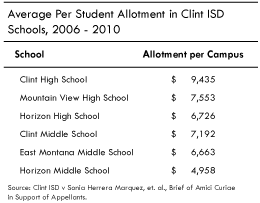SB 2144: school finance reform needs student-centered equity
Michael Barba
The Texas Conference of Catholic Bishops support SB 2144. This is the best first step toward addressing our school finance system, and runs parallel to our work: following the 2017 session, the bishops have charged the TCCB with providing recommendations upon how to improve the finance system. Our work will shed light on the fundamental problems and solutions to them.
For example, problem is that Texas collects revenue through a local property tax to fund a statewide obligation. This was not always true: the obligation to maintain education was established in our 1876 constitution, and we supported it through statewide taxes. However, in 1968, Texas prohibited a statewide property tax,[1] so we began to rely upon a local property tax.[2] The result was widely inequitable funding. Recapture was established to remedy this problem.[3] 
But recapture points to a second problem. Recapture aims at district equity, not student equity. Currently, revenue does not flow at all in the way intended by the state system of weights.[4] This fact prompted families in far West Texas to file suit against their district because some schools received over 40 percent more than others. (see figure at right) The Texas Supreme Court ruled against the family because they had not exhausted their administrative appeals process. However, the completion of this process comes too late to help their children. Our state must place a higher priority upon maintaining a student-centered system. The TCCB plans to provide guidance on this issue in the future, and we look forward to the study commissioned by this bill.
[1] S.J.R. 32, 60th R.S. (1967). This became Article 8, Section 1-e.
[2] The problem was summarized in Edgewood I, at pages 2 and 6:
There are glaring disparities in the abilities of the various school districts to raise revenues from property taxes because taxable property wealth varies greatly from district to district. The wealthiest district has over $14,000,000 of property wealth per student, while the poorest has approximately $20,000; this disparity reflects a 700 to 1 ratio.… The structure of school finance [in 1876] indicates that such gross disparities were not contemplated. Apart from cities, there was no district structure for schools nor any authority to tax locally for school purposes under the Constitution of 1876. The 1876 Constitution provided a structure whereby the burdens of school taxation fell equally and uniformly across the state...
[3] S.B. 7, 73rd R.S.
[4] Roza, Marguerite, Educational Economics: Where do School Funds Go?, 1st ed. (Washington, D.C.: Urban Institute, 2010), 33- 60; Hill, Paul T., Marguerite Roza, and James Harvey, Facing the Future: Financing Productive Schools (Seattle, WA: The Center on Reinventing Public Education, December 2008), 9-17; Hansen, Janet S., Gina Ikemoto, Julie Marsh, and Heather Barney, School Finance Systems and Their Responsiveness to Performance Pressure: A Case Study of Texas (Seattle, WA: Center on Reinventing Public Education, March 2007), 37. Hansen and her colleagues concluded about Texas, “the state funding formulas [have] for many years been weighted by student needs. Statewide, however, it appeared to us that use of weighted formulas for distributing district funds to schools was still very much the exception rather than the rule.”
